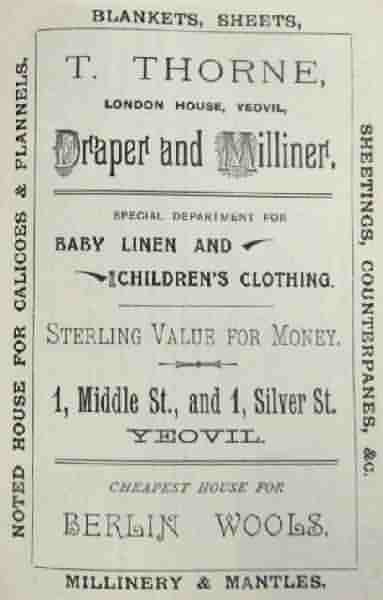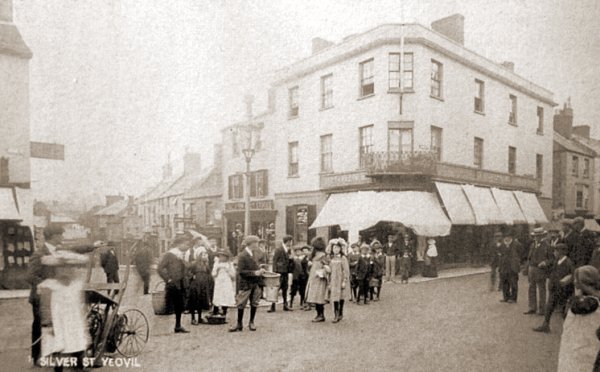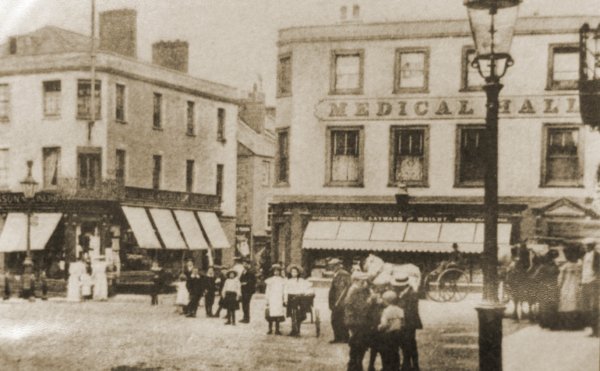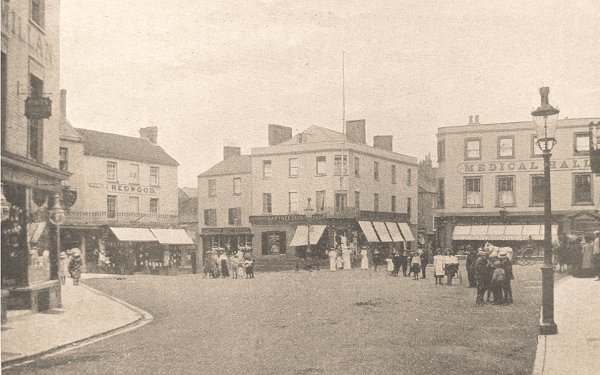Yeovil people
Thomas Thorne
Draper of London House
Thomas Thorne was born in 1859 at Fremington, Devon (close to Barnstaple), the youngest of seven (at least) children of Drainer & Tile Maker John Thorne (b1801) and his laundress wife Ann née Nankivel (b1814). The 1861 census recorded the family at Fremington but by 1871 12-year old Thomas was living in Barnstaple and working as one of four Draper's Assistants in Thomas Fry's draper's shop in Boutport Street, Barnstaple.
By 1881 Thomas had moved yet again and in the census was recorded working and living in the large draper's shop (photographed below) at 18 High West Street, Dorchester, Dorset, run by Joshua T Soundy.
On 2 March 1886 Thomas married Julia Mary Fudge at Holy Trinity church, Weymouth. They were to have a total of six children but only three survived childhood. Almost immediately they moved to Yeovil where their first son, Thomas, was born the following year. Thomas set up his own draper's business at London House, in the Borough, on the corner of Middle Street and Silver Street.
|
In the 1891 edition of 'Where to Buy' Thomas Thorne's business was given the following description -
Mr
Thomas
Thorne The year 1645 was an eventful one in the history of England, and the forces of the Crown and of the Parliament were then engaged in debating the question of ship money across the battlements of castles and walled towns in many parts of Somerset. It appears that in these controversies the vicinity of Yeovil formed a portion of the scene of action, and we learn that in 1646 Colonel Phelips, the Lord of the Manor, suffered confiscation of his estates, including "rents of the Borough of Yeovil, amounting to £13 6s. 8d., all of which, except thirty-eight shillings, were payable out of certain houses in the borough, which houses were lately burnt, and so the rent is lost. Possibly it may have been, on the whole, a fortunate accident for the town, and that the old houses were replaced by better and more commodious ones. About this time, however, we learn that a draper's shop was opened in Pitt Lane, and at the present day the same business is carried on on the same site, under the energetic proprietorship of Mr Thomas Thorne, draper and milliner, of 1 and 2, Middle Street, and 1, Silver Street. Whatever the business may have been like in the middle of the 17th century it is now impossible to say, but at the present time it is an extensive and thoroughly representative trade, carried on on the most approved modern lines. In recent years the premises have been enlarged, rearranged, and in every way adapted to the requirements of a large business; and although the present proprietor has only been about one year connected with it, he has, through his energy and enterprise, added fresh life to this historic business, and introduced many desirable improvements.
The site
of the
premises
is,
perhaps,
one of
the best
and most
commanding
in the
town,
being
under
the
shadow,
as it
were, of
St
John's
Parish
Church,
in the
centre
of the
borough,
and at
the head
of the
main
thoroughfare
to and
from the
railway
station.
Every
advantage
of site,
position
and
internal
arrangement
has been
utilized
for
facilitating
the
despatch
of
business
with the
least
possible
trouble
or
inconvenience
to
customers.
Mr
Thorne
has a
long
experience,
and both
in the
purchase
of his
stock
and the
general
organisation
of the
house
shows
that he
is
resolved
to
maintain
the best
traditions
of the
house
and to
keep
well
abreast
of the
requirements
of the
times.
The
stock is
very
comprehensive,
including
several
special
departments,
and in
every
case the
very
best
qualities
of goods
are
offered
at the
lowest
market
prices.
The
adoption
of, and
rigid The work-rooms are commodious, a large staff of experienced milliners and dressmakers, under able supervision, are constantly employed, and the work executed can be relied on for style, fit and finish. The gentlemen's outfitting department is replete with all modern requirements, and Mr Thorne is constant in his supervision of each branch. It would be impossible in a brief outline to give details of this very unique business, but it may be taken that the stock is complete throughout, the staff of assistants and skilled workers are most experienced, and customers can always rely on prompt and courteous attention.
|
London House was built around 1838 and, for most of its existence, was a draper's shop occupied in turn by George Wadman, then John Wiltshire. In the 1891 census London house was occupied by 32-year-old draper Thomas with Julia and three young sons all aged under 4. Also resident were four drapers' assistants, a cook, a nurse and a housemaid. Similarly, in the 1901 census 42-year-old draper Thomas Thorne was still in residence with his wife Julia and son Reginald. Additionally, living on the premises, were nine young ladies aged between 17 and 29, including five drapers assistants, two milliners, a cook and a housemaid. Later that year, however, Thomas Thorne and his family moved from London House which was then occupied by linen drapers, Hartree & Son. London House was demolished in 1913 and the present building built for the Midland Bank opened in 1914. It is now occupied by the HSBC.
Thomas, however, had a complete career change. A draper since he was a 12-year old boy, he bought the Bull Hotel in High Street, Sittingbourne, Kent. In the 1911 census he was listed as a Hotel Proprietor and was living at the Bull with Julia and their two sons Harold and Reginald. In addition to his immediate family Thomas' niece was living with them as well as three visitors, a cook, barmaid, waiter, waitress and three domestic servants.
Thomas Thorne died in Sittingbourne in the spring of 1915. He was aged 56.
gallery

From my
collection. This
colourised photograph
features in my
book "Lost Yeovil"
This photograph of the Borough dates to about 1865. At centre is Middle Street with the Medical Hall to the right and London House, at this time occupied by draper John Wiltshire, to the left.

This
colourised photograph
features in my
book 'Yeovil From Old Photographs'.
This photograph was taken by Yeovil Photographer Jarratt Beckett and published in his 1897 book "Somerset viewed through a Camera". At left is London House. At right is the side of the Medical Hall which, at this time was occupied by wholesale and retail chemists Gatward & Wright. Next door to the Medical Hall was the International Stores.

Thomas Thorne's advertisement in the 1895 edition of Whitby's Yeovil Almanack Advertiser.

This postcard was produced around 1900 from the Borough, looking towards the junction of Silver Street at left and Middle Street at right. The large building on the corner was London House which was built in the 1830s and occupied mostly by a succession of drapers (at this time by Thomas Thorne). Going down Silver Street was Singleton's boot stores, a greengrocer and then the Half Moon Hotel.

Thomas Thorne's London House drapery and the Medical Hall enlarged from the following postcard of 1911.

A postcard of the Borough dated 1911 showing London House at centre, on the corner of Silver Street and Middle Street. At this time it had just been occupied by linen drapers, Hartree & Son.